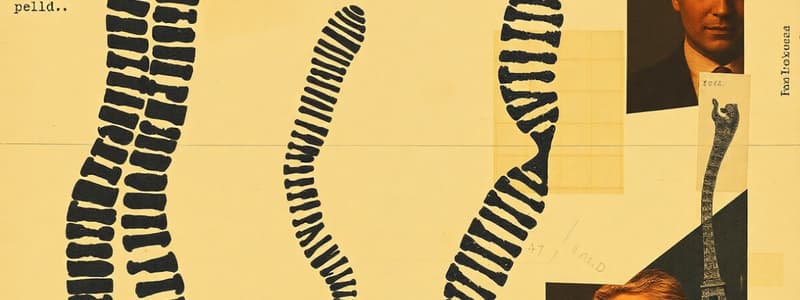Podcast
Questions and Answers
How many chromosomes does a human cell contain?
How many chromosomes does a human cell contain?
- 44 chromosomes
- 46 chromosomes (correct)
- 48 chromosomes
- 22 chromosomes
Which principle states that children resemble their parents more closely than any other person?
Which principle states that children resemble their parents more closely than any other person?
- Chance Principle
- Principle of Dominance and Recessiveness
- Principle of Variability
- Principle of Consistency (correct)
What are the sex chromosomes in a typical human male?
What are the sex chromosomes in a typical human male?
- XY (correct)
- YY
- XYX
- XX
What defines the phenotype of an individual?
What defines the phenotype of an individual?
If both alleles of a gene are dominant, what will the offspring inherit?
If both alleles of a gene are dominant, what will the offspring inherit?
What is the role of afferent neurons in the nervous system?
What is the role of afferent neurons in the nervous system?
Which of the following best describes the function of the myelin sheath?
Which of the following best describes the function of the myelin sheath?
What does the term 'synapse' refer to in the context of neuroscience?
What does the term 'synapse' refer to in the context of neuroscience?
What is the primary function of inhibitory neurotransmitters?
What is the primary function of inhibitory neurotransmitters?
In Bronfenbrenner's ecological systems theory, which layer directly includes the individual's families and friends?
In Bronfenbrenner's ecological systems theory, which layer directly includes the individual's families and friends?
Flashcards are hidden until you start studying
Study Notes
Biological Transmission
- Heredity begins at conception with the combination of male sperm and female ovum, resulting in a zygote.
- The zygote's nucleus contains hereditary materials from both parents.
Heredity Materials
Chromosomes
- Chromosomes are structures that carry genetic information from both parents to offspring.
- Composed of DNA and proteins and found within the nucleus.
- Each parent contributes 23 chromosomes, totaling 46 in a human cell.
- Autosomes: Out of 46 chromosomes, 44 are autosomes (22 pairs) that determine various traits.
- Sex Chromosomes: 2 out of 46 are sex chromosomes (1 pair) that determine biological sex; XY indicates male, XX indicates female.
Genes
- Genes act as hereditary units within chromosomes, usually present in pairs.
- Genetic information is encoded in DNA across all cells, except those lacking nuclei.
Genotype and Phenotype
- Genotype: Includes all genetic traits, both visible and hidden; consists of dominant and recessive alleles.
- Allele: Variants of a gene.
- Heterozygous: Contains both dominant and recessive alleles.
- Homozygous: Contains two dominant alleles.
- Allele: Variants of a gene.
- Phenotype: All observable physical characteristics influenced by genotype and environmental factors. Genotype and phenotype are distinct concepts.
General Principles of Heredity
- Principle of Consistency: Species reproduce their own kind; offspring closely resemble parents.
- Principle of Variability: Offspring may not look identical to parents due to hereditary factor combinations.
- Chance Principle: Some hereditary traits may arise unpredictably, such as the sex of a child.
- Principle of Dominance and Recessiveness: Genes can be dominant or recessive. Dominant genes are expressed in the phenotype, while recessive genes can be carried without being expressed.
Urie Bronfenbrenner: Ecological Systems Theory
- Focuses on an individual’s environment and its quality/context.
- Microsystem: Immediate environment with structures the individual interacts with, such as family and friends.
- Mesosystem: Connections between microsystems affecting the individual, like linked relationships.
- Exosystem: Larger social systems where the individual does not have direct involvement.
- Macrosystem: Outermost layer consisting of cultural values, customs, and laws.
- Chronosystem: Encompasses changes and experiences over time, including both external and internal factors.
The Nervous System
- The system that connects the brain to the body through the network of neurons.
Neurons
- Neurons are the basic structural units of the nervous system.
- Types of Neurons:
- Afferent Neurons: Carry sensory information to the brain.
- Efferent Neurons: Transmit signals from the brain to muscles and glands.
- Internuncial Neurons: Connect afferent and efferent neurons.
Parts of a Neuron
- Cell Body/Soma: Contains the nucleus and is where neuronal processes originate.
- Dendrites: Receive signals from other neurons and direct them to the cell body.
- Axon: Transmits signals away from the cell body; covered by myelin sheath for insulation and faster impulse transmission.
- Myelin Sheath: Protective coating around the axon that enhances signal velocity.
- Synaptic Terminals/Buttons: End of axon branches that relay messages to other cells, containing synaptic vesicles with neurotransmitters.
Neurotransmitters
- Exist in over 40 varieties, fulfilling various functions in the brain.
- Excitatory Neurotransmitters: Stimulate the firing of postsynaptic neurons, generating action potentials.
- Inhibitory Neurotransmitters: Block potential-generating changes in responding neurons.
Studying That Suits You
Use AI to generate personalized quizzes and flashcards to suit your learning preferences.




